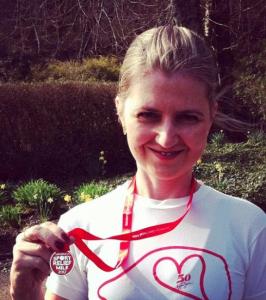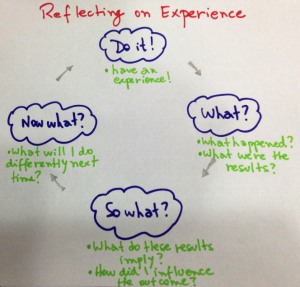Learning is Made of Beliefs, not Barriers –
By Malu Sciamarelli
December 2007, Sunday 4:30am: Slowly crawling out from the warmth of my bed, I saw my running kit and race bib patiently waiting. Smiling, I got up, dressed and went on to cross the finish line of my first 10k race in 67 minutes. Not bad for a beginner!
Looking back, I saw how it all started: jogging around the block without coughing up a lung, doing research, hiring a personal trainer and eating healthy food. My sights were set high despite warnings from doctors after my previous serious illness: I wanted to run street races! The feeling of accomplishment from that first race has motivated me to run 20 more.
 After every training or race, I was so motivated, and I tried to pass this on to my students, sometimes with mixed success. Motivation is essential for learning, but it has different meanings for different people and should be developed not forced.
After every training or race, I was so motivated, and I tried to pass this on to my students, sometimes with mixed success. Motivation is essential for learning, but it has different meanings for different people and should be developed not forced.
I thought about my first run and my motivation. Three questions popped up:
– Why people decide to do something,
– How hard they are going to pursue it and
– How long they are willing to sustain that activity.
I thought about the Motivational Running techniques that broke my barriers – I can’t run – and which limited my real ability, and thought about a common student barrier – I can’t learn English. Would the same strategy work? In the classroom, I converted running techniques to learning techniques, as follows:
1. Set goals
In running, you set goals to monitor your progress and with each success your enthusiasm for running soars. Remember:
– Have specific deadlines;
– set realistic but challenging goals;
– write and review your goals.
With my groups, we create a contract with specific learning goals to be followed during the course, and post it on the classroom wall.
2. Utilize a log
A log helps to keep you on track and allows progress monitoring. Runners regularly review their training logs and gain motivation.
In my classroom, we have a learning diary, in which students are responsible for recording their progress individually and as a group.
3. Implement the buddy system
The Buddy system is a procedure in which two people operate together to monitor and help each other. Running with others provides accountability, builds friendships and provides mutual motivation on tough days.
My students have buddies and they operate by encouraging each other.
4. Surround yourself with reminders
Race photos and messages can sustain motivation.
In my classroom, sometimes students arrive and find post-its in different places with specific messages; occasionally the class starts with a video or simply with online posts.
5. Be creative with the process
Doing the same thing leads to boredom and burnout. In running, you can vary your workout routine.
Whenever possible, I try to start my classes in different places in school, such as the garden and move to the classroom. We do a variety of practical projects and enjoy background music.
6. Do more to boost your motivation
In my trainings or races, when I wanted to quit, I remembered a quote and that inevitably helped me.
Each student in my groups is responsible for finding a motivational quote that can be referred to in moments of difficulty. They are also encouraged to share experiences of using English outside the classroom.
7. Occasionally enter a competition
In running, if you want to increase your motivation and feel competitive adrenaline, you must enter the occasional race. The spillover excitement motivates you afterwards to try more races.
Within my groups, we create events, such as workshops, project presentations, theatre role-plays and student judges give “peer feedback”.
8. Reward your successes
In running, rewards can be a powerful motivator. When you succeed, you do something nice for yourself, such as a meal at a nice restaurant – any idea is great, as long as you follow the bottom line “be good to yourself”.
In learning, although intrinsic motivation is hindered by tangible rewards that control, I believe motivation is related to enjoyment, vitality and self-esteem. So, by rewarding success in unexpected ways, it need not be seen as controlling.

By following these steps, my students are able to create motivational conditions, where they have a pleasant and supportive atmosphere in the classroom; they can help each other generate initial motivation, increasing their expectancy of success; they can maintain motivation by making learning stimulating and increase their self-confidence to breakdown self-imposed barriers. At the end of each class, I and the students always reflect using the Reflective Learning Cycle (Thornbury S. and Watkins P.), in which they can see their learning in a motivational, personal and meaningful way.
At the end of each class, I and the students always reflect using the Reflective Learning Cycle (Thornbury S. and Watkins P.), in which they can see their learning in a motivational, personal and meaningful way.
How about us, teachers? What do you believe motivates us? We may have different answers, but for me, it’s when my passion to teach is caught by my students. – Malu Sciamarelli
Malu has been working in Brazil for 20 years as an English teacher, materials designer, translator and consultant for publishers. She has taught in schools, language institutes and in companies, where she has developed a new concept of ELT in the workplace. She’s passionate about teaching. She believes teachers can affect how students perceive the world around them; they can ignite a spark of curiosity and help them develop their own creativity; they can help them overcome fears, express themselves, initiate ideas, plans, actions and a desire for lifelong learning. She’s also an enthusiastic runner and she loves dogs. Website: malusciamarelli.com


Hi Malu,
This post is just full of great suggestions for keeping students engaged in the learning process. I’m going to be helping students find and create reminders of the kind of learning they want to engage in, the goals they want to achieve (as for myself, I think I found some quotes from Barry’s post just across the way). I also played with the idea of a buddy-system at one time, but misplaced the idea in the normal crush of teaching. Thank you for the reminder.
Teaching and learning a language is kind of an endless marathon. Your suggestions will definitely help me and my students keep moving forward.
Kevin
Malu,
You bring so much creativity to your classes! If learning a language is like running a marathon, this is not a boring one. Thanks for the inspiration.
Melis
Hi, Kevin
Thank you for your comments! I’m so glad you think the suggestions I shared here will help your students. They’ve been helping not only my students, but also myself. I remember when I started running street races, always in the 8th kilometer I was so exhausted that the only thing I could do was ask myself why I was there. Then, I started saying to myself my favorite quote – and that gave me strength. Finally, I could remember: my dream!
We tend to think that dreams are so beautiful and the path to get to them is always glamorous too, and that we are motivated all the time. But in reality with all teaching, learning and in fact life, the whole process is indeed an endless marathon: hard-work, ups and downs, pain and sometimes frustrations, yet there are realizations and accomplishments – and that is so motivational. Once you build your way to get to a point, you start to set your eyes at another that is further away. We never stop looking for other dreams and lessons to be learnt, do we?
Malu
Hi,Melis
Thank you for your comment! I wish you happy runs and productive classes!
Malu
impressive Malu. I mean your enthusiasm and devotion is impressive. The parallels between running and teaching are inspiring and motivating. Adding a sense of athletic competition to the process of teaching and learning is really interesting.
Hi, Ahmad
When I started running, I learnt that the competition is always against ourselves, and the runners motto is “no one gets there alone” – we are a family united by cooperation and respect. This is the spirit I bring to my classes: try to better every day, but don’t compare yourself to the others. In a motivational and respectful learning environment, my students develop a sense of community and cooperation, and we share memorable experiences!
Thank you so much for your comments!
Malu
Oh my, whom should I think of first? The application to my own life or to my students’ process of learning in the classroom? You lay it out so clearly, I really should try to work on both!
These points work are very useful when working with struggling learners too.
Naomi
P.S personally, I’ll settle for walking, not running…
Hi, Naomi
I use all these techniques in running and some in my life, as well as to my students’ process of learning in the classroom. I can say that I’m motivated by them as much as they as motivated by me. It’s a cycle!
And I confess that some days when I want to appreciate the view, I go for a walking too – and feel the same adrenaline as running!
Thank you so much for your comments!
Malu
Hey Malu,
As you mentioned, we need to enjoy what we are learning, and I am sure all your students do!!!!
Keep rocking!!
XX
Adriana Gomes
Hi, Didi
Thank you so much for you comment! I’m sure all your students do too!
Malu
xx
Dear Malu,
Wonderful suggestions here! I especially like the idea where the learner has to look for a motivational quote that keeps them going in times of adversity, who would’ve thought of that?
Lovely way of transferring lesson learnt from your experience to learners in the classroom.
p/s : It’s also a motivation for me to keep jogging despite the little glitches I’m facing at the moment.
Warm regards,
Ratna
Hi, Ratna
The idea of using a motivational quote came up in a race I wanted to quit before the finish line, when I thought to myself: “you haven’t come so far to quit now”. At that moment, I remembered the quote, and said: “This is it!” I was exhausted, but could cross the finish line. Since then, I’ve been using the same quote not only in races, but in my life, and have incorporated it into my classes with great success!
Thank you for your comments!
Malu
ps: here’s a little secret I’ve learnt – these strategies help running and running will help you motivated 😉
Hey huney,
You’re an amazing person and an awesome teacher and writer! I really look up to you!! =)